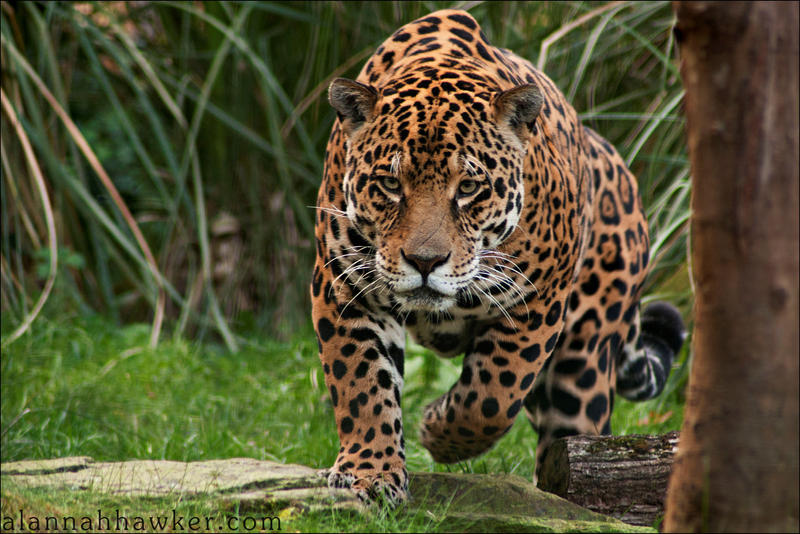Post by dinosauria101 on Feb 13, 2019 21:17:00 GMT 5
Jaguar - Panthera onca
The jaguar (Panthera onca) is a big cat, a feline in the Panthera genus, and is the only Panthera species found in the Americas. The jaguar is the third-largest feline after the tiger and the lion, and the largest in the Western Hemisphere. The jaguar's present range extends from Southern United States and Mexico across much of Central America and south to Paraguay and northern Argentina. A study of the Jaguar found average weights of 95 kilograms (210 lb) in the Brazilian Pantanal and average weights of 55 kg (121 lb) in most of Central America. A short and stocky limb structure makes the jaguar adept at climbing, crawling and swimming. The head is robust and the jaw extremely powerful. The jaguar hunts wild animals weighing up to 300 kilograms (660 lb) in dense jungle, and its short and sturdy physique is thus an adaptation to its prey and environment.

Grey Wolf (pack of 4) - Canis lupus
The Grey Wolf (Canis lupus) is the largest wild canid, males averaging between 70 and 110 pounds depending on subspecies. The Wolf has a specialized body that has made it one of the world's most efficient hunters. Its powerful neck is a very important adaptation: it has to be strong to support the wolf's large head and is crucial for bringing down prey. The skull is 31cm (12 inches) long and is armed with an impressive array of large canines and carnassial teeth which, when coupled with huge jaw muscles that are evident from the large sagittal crest and wide zygomatic arches, give it an incredible biteforce that is strong enough to break the bones of prey and even crack the femur of moose. Wolves primarily feed on medium to large sized ungulates (up to the size of bison 10–15 times larger than themselves), though they are not fussy eaters. Medium and small sized animals that may supplement the diet of wolves include marmots, beaver, hares, badgers, foxes, weasels, ground squirrels, mice, hamsters, voles and other rodents, as well as insectivores.
![]()

Credit to Wikipedia
NOTE: For those who don't know, the ranges of jaguars and wolves overlap in Mexico.
The jaguar (Panthera onca) is a big cat, a feline in the Panthera genus, and is the only Panthera species found in the Americas. The jaguar is the third-largest feline after the tiger and the lion, and the largest in the Western Hemisphere. The jaguar's present range extends from Southern United States and Mexico across much of Central America and south to Paraguay and northern Argentina. A study of the Jaguar found average weights of 95 kilograms (210 lb) in the Brazilian Pantanal and average weights of 55 kg (121 lb) in most of Central America. A short and stocky limb structure makes the jaguar adept at climbing, crawling and swimming. The head is robust and the jaw extremely powerful. The jaguar hunts wild animals weighing up to 300 kilograms (660 lb) in dense jungle, and its short and sturdy physique is thus an adaptation to its prey and environment.

Grey Wolf (pack of 4) - Canis lupus
The Grey Wolf (Canis lupus) is the largest wild canid, males averaging between 70 and 110 pounds depending on subspecies. The Wolf has a specialized body that has made it one of the world's most efficient hunters. Its powerful neck is a very important adaptation: it has to be strong to support the wolf's large head and is crucial for bringing down prey. The skull is 31cm (12 inches) long and is armed with an impressive array of large canines and carnassial teeth which, when coupled with huge jaw muscles that are evident from the large sagittal crest and wide zygomatic arches, give it an incredible biteforce that is strong enough to break the bones of prey and even crack the femur of moose. Wolves primarily feed on medium to large sized ungulates (up to the size of bison 10–15 times larger than themselves), though they are not fussy eaters. Medium and small sized animals that may supplement the diet of wolves include marmots, beaver, hares, badgers, foxes, weasels, ground squirrels, mice, hamsters, voles and other rodents, as well as insectivores.

Credit to Wikipedia
NOTE: For those who don't know, the ranges of jaguars and wolves overlap in Mexico.





